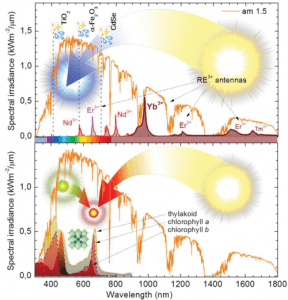Harnessing energy from sunlight – the most abundant, readily available source of energy – has the major shortcoming that both natural and artificial systems are often limited to only a part of the electromagnetic spectrum. This fact results from the narrow spectral selectivity of the underlying conversion systems which limit the overall energy yield in both natural and artificial photosynthesis. Despite recent developments and some good progress, a number of critical challenges remain to be solved for efficiently harvesting energy from sunlight.
 In photovoltaic devices (PVs) several issues need to be addressed to arrive at an improved energy conversion efficiency: First, the photon energy may not match the system so that absorption is not possible. Second, of the remaining photons absorbed only a fraction will contribute to energy generation resulting from secondary processes which reduce the quantum efficiency. Third, photons from the ultraviolet light range may cause adverse effects, such as photo-damage and recombination reactions further lowering the overall energy yield.
In photovoltaic devices (PVs) several issues need to be addressed to arrive at an improved energy conversion efficiency: First, the photon energy may not match the system so that absorption is not possible. Second, of the remaining photons absorbed only a fraction will contribute to energy generation resulting from secondary processes which reduce the quantum efficiency. Third, photons from the ultraviolet light range may cause adverse effects, such as photo-damage and recombination reactions further lowering the overall energy yield.
Wondraczek et al. review these technical challenges and present two solutions commonly used for photovoltaics: On the one hand, the available spectrum can be more efficiently covered by designing systems that contain several chromophores chosen to match the spectral range. On the other hand, luminescent converter materials are selectively employed to absorb unmatched photons and to re-emit them at a wavelength range that is more suitable for PVs. Currently, the working principle of these novel materials has been demonstrated, but many issues for integration of these materials into robust large-scale applications remain to be addressed. An energetic efficiency larger than 10% is highly desirable, but has not yet been achieved outside the laboratory. Novel design strategies on a system scale still have to be worked out, going along with a further improvement of available materials.

















